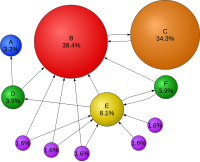
Photo from wikipedia
Redirected Walking (RDW) algorithms aim to impose several types of gains on users immersed in Virtual Reality and distort their walking paths in the real world, thus enabling them to… Click to show full abstract
Redirected Walking (RDW) algorithms aim to impose several types of gains on users immersed in Virtual Reality and distort their walking paths in the real world, thus enabling them to explore a larger space. Since collision with physical boundaries is inevitable, a reset strategy needs to be provided to allow users to reset when they hit the boundary. However, most reset strategies are based on simple heuristics by choosing a seemingly suitable solution, which may not perform well in practice. In this paper, we propose a novel optimization-based reset algorithm adaptive to different RDW algorithms. Inspired by the approach of finite element analysis, our algorithm splits the boundary of the physical world by a set of endpoints. Each endpoint is assigned a reset vector to represent the optimized reset direction when hitting the boundary. The reset vectors on the edge will be determined by the interpolation between two neighbouring endpoints. We conduct simulation-based experiments for three RDW algorithms with commonly used reset algorithms to compare with. The results demonstrate that the proposed algorithm significantly reduces the number of resets.
Journal Title: IEEE Transactions on Visualization and Computer Graphics
Year Published: 2022
Link to full text (if available)
Share on Social Media: Sign Up to like & get
recommendations!